New Orleans is situated on the Mississippi River near the Gulf of Mexico.
It is a major city in the state of Louisiana.
The city is most notable for its Creole cuisine, annual festivals, unique music, and, most importantly, Mardi Gras.
New Orleans has a humid, sub-tropical climate.
This climate produces hot summers, mild winters, and luscious green lawns with abundant sunny days.
The ideal climate and location for alligators.
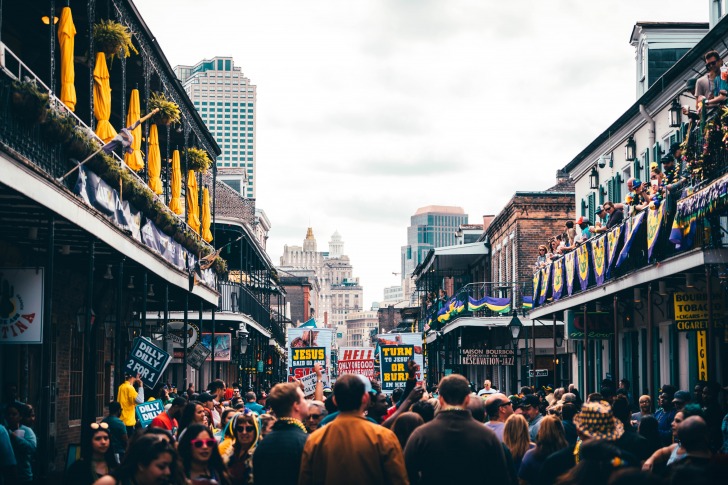
Contents
So… Are There Alligators in New Orleans?
According to the Louisiana Wildlife and Fisheries Department, Louisiana and Florida have the largest populations of alligators in the United States.
The department further states that the natural habitat of alligators in North America stretches eastward from central Texas to North Carolina.
Louisiana and Florida have the largest alligator populations, with approximately a million alligators in each state.
The coastal marshes are the most common place you’ll find an alligator in Louisiana.
But they are also present in lakes, canals, rivers, ponds, swamps, and Louisiana Bayous.
Louisiana has approximately 4.5 million acres of habitable alligator land, of which 3 million are coastal marshes.
Older male and non-breeding female alligators spend most of their time in deep water marshes.
In contrast, breeding females, baby alligators, and newly hatched alligators spend most of their time in shallow marshes with plenty of vegetation, so they are not easily detectable.
Contrary to many cheesy Hollywood movies shot in New Orleans, chances of seeing an alligator within the city are very slim.
If you’re lucky, you may see some alligators in City Park.
There are a few roaming in the waterways and lagoons.
Apart from City Park, most alligators can be found in the marshes and swamps around the city.
Various swamp tours will take you out to go sightseeing.
Much of where New Orleans is today used to be wetlands filled with alligators, but the swamp has been drained, and most of the alligators that used to call it home are gone.
But the city is still surrounded by natural alligator habitat.
It isn’t unusual to see alligators just outside the city.
You’ll most certainly find alligators in New Orleans Bayou, located approximately 45 minutes drive outside the city.
To answer the question, yes, you will find alligators around New Orleans due to the water environment and the city climate.
However, most of the alligators are confined to a certain area within the city.
Alligator Species in New Orleans
Only one species of an alligator is present in the United States: the American Alligator (Alligator mississippiensis).
The American Alligator is native to the southeastern United States.
The largest population of this species of alligator can be found in Louisiana, which is home to over half of the total population in the US today.
The American Alligator is hunted for its hide and meat.
It was hunted to the point of being listed as endangered.
Wildlife conservationists have been involved in protecting the species and regulating alligator hunting.
Today, the numbers have climbed significantly again, but permits are required to hunt alligators.
Is it safe to swim in New Orleans?
To answer this question, we will need to look at the various types of water in and around New Orleans.
The Mississippi River is the most prominent water body running through New Orleans.
It is unsafe to swim in the Mississippi River for various reasons, but the most critical reason is its strong current.
For example, the strongest current is near New Orleans, where the flow reaches speeds of up to 600,000 cubic feet per second.
That is incredibly fast and dangerous enough to kill even the most skilled swimmer.
The fourth largest river in the world is known for taking lives through drownings.
Apart from the current are the dangerous sea creatures that call the Mississippi River home, like snapping turtles, snakes, the occasional bull shark, and alligators.
The Mississippi River is a freshwater river, and you may find alligators along some slower-moving river areas or on the river banks.
In addition, the river is very polluted.
The river has tested positive for high amounts of PCBs (polychlorinated biphenyl), mercury, bacteria, and sediment, making swimming very harmful.
The Mississippi River is one of the world’s top ten most polluted rivers.
To the north of the city is Lake Pontchartrain.
The lake was once plagued by harmful pollution, and residents were advised against swimming in the lake.
However, the situation has improved significantly, and swimming in the lake is now safe.
However, swimmers should still practice reasonable caution.
No alligators live in the lake, but alligators live nearby in wetlands and bayous.
Lake Borgne is situated east of New Orleans, about an hour away.
It’s a lagoon formed by the Gulf waters.
It is safe to swim in this lake, but reasonable caution should still be practiced as the lake opens up to the Gulf of Mexico.
There have been reports of a shark attack on Lake Pontchartrain.
Although shark attacks aren’t the norm, they can still occur.
And finally, the wetlands surrounding the city.
For apparent reasons, swimming in a swamp is not a good idea.
The main reason, of course, is the presence of alligators in the swamps.
Apart from the alligators, a series of other potential hazards, such as pollution and other dangerous animals living in the swamps, may threaten safety.
You may be better off swimming in a swimming pool than taking your chances in the natural water bodies in and around New Orleans.
It is not prohibited, many people still swim in these water environments.
However, it is advised not to do so for health and safety reasons.
Interesting Alligator Facts in New Orleans
Alligators live in the marshes and swamps around New Orleans.
They learn to distinguish the different sounds in their environments, such as boats or intruders, and swiftly retreat into the water.
This is a survival mechanism.
Alligator populations previously dropped significantly due to unregulated hunting.
These reptiles were prized for their hide and delicate meat.
However, thanks to research, observation, careful management, and stewardship, the numbers of their populations have grown again and are no longer considered endangered.
Alligators are not active hunters but opportunistic hunters who wait for their prey to get close before they attack.
In addition, alligators have an excellent sense of smell and eyesight during the night.
When they do hunt, they prefer to do it at night.
The American Alligator is considered a reptile and the largest in North America.
Alligators are cold-blooded animals and require outside heat sources to regulate their body temperatures.
That’s why you’ll often notice them basking in the warm sun and why they prefer areas with warmer climates.
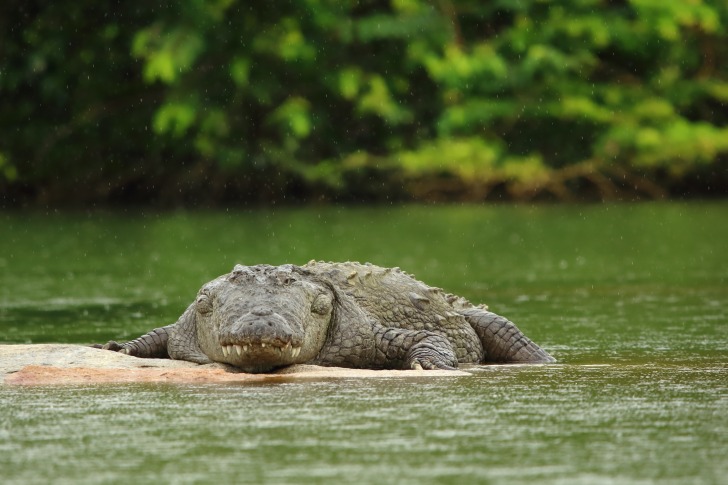
Alligators vs. Crocodiles
Many people tend to confuse alligators with crocodiles and vice versa.
But, a few key differences will help you to identify one from the other.
One of the first things you will notice is that the snout of an alligator and a crocodile differ in shape.
An alligator has a rounded U-shaped snout, while a crocodile has a longer, V-shaped snout.
Both these reptiles are shy and timid.
Location is another critical differentiator.
Most crocodiles are found at the southern tip of Florida.
At the same time, alligators live in freshwater and brackish environments from central Texas to North Carolina and further down in the southeast United States.
Alligators prefer to be closer to the shore and live in swamps, wetlands, marshes, lakes, lagoons, and rivers.
At the same time, crocodiles are comfortable with being in open streams due to their ability to regulate salt.
The next thing to look out for is the color of the alligator or crocodile.
Crocodiles are light green, gray, or brown.
On the other hand, alligators are usually darker green or black, allowing them to camouflage better with mud.
There is a significant size difference between these two reptiles.
Crocodiles tend to be about three feet longer than alligators.
Crocodiles have visible bottom teeth, while alligators have visible upper jaw teeth when they close their snouts.
3 Safety Tips for Swiming in Alligator-infested Waters
- The first safety tip is to avoid alligator-infested water. Have you ever heard of the saying it’s better to be safe than sorry? Well, it couldn’t possibly be more applicable than in this instance. Sometimes it’s better not to run the risk when swimming in alligator-infested water. It may be best to avoid swimming in areas known to host alligators altogether.
- Retreat. Always keep at least 30 feet between yourself and the alligator. This may not always be possible, especially if you are unaware of your surroundings. Lack of awareness could potentially mean the difference between life and death. Remember, it was mentioned earlier that alligators are opportunistic hunters. Alligator attacks are rare, but they do happen, even more so when you enter alligator territory unaware of your surroundings.
- Be aware when alligators hiss at you. This indicates that they feel threatened, and you should immediately retreat. You should back away from the alligator slowly.
Conclusion
New Orleans is surrounded by freshwater and saltwater environments.
You will find alligators in and around the city, as the city hosts the perfect climate and habitat for alligators.
New Orleans has a semi-tropical climate with hot and humid summers and mild winters.
The area surrounding New Orleans is the ideal habitat for alligators, such as bayous, marshes, swamps, lakes, rivers, and lagoons.
Always practice reasonable caution when traveling to or through a known city to host alligators.
New Orleans Safety Overview
READ THE FULL REPORT: New Orleans Safety Review
Safety Index:
- OVERALL RISK: MEDIUM
- TRANSPORT & TAXIS RISK: LOW
- PICKPOCKETS RISK: HIGH
- NATURAL DISASTERS RISK: MEDIUM
- MUGGING RISK: HIGH
- TERRORISM RISK: LOW
- SCAMS RISK: HIGH
- WOMEN TRAVELERS RISK: MEDIUM
Frequently Asked Questions
When do alligators mate in Louisiana?
Mating season for alligators is usually from April to May each year.
During the spring, bull alligators will bellow to warn off other male alligators and attract suitable female alligators to mate.
This process will continue for approximately two months to see which males will get to mate with a suitable female.
Alligators can get pretty aggressive during this time to secure a female to mate with and to protect their territory.
Females will look for and find nesting sites from June through July.
Nests are built from vegetation in the marshes, where the female typically lays ten to 35 eggs or up to 90 eggs.
What is the difference between alligator hatchlings and crocodile hatchlings?
Alligator hatchlings can be identified by their color.
They are black with yellow streaks across their bodies.
Crocodile hatchlings are more of a light green or gray color with yellow stripes.
Are alligators or crocodiles more aggressive?
Crocodiles tend to be more aggressive towards humans.
How many types of alligators are there currently in the world?
Only two types of alligators are present today: the Chinese alligator and the American alligator.
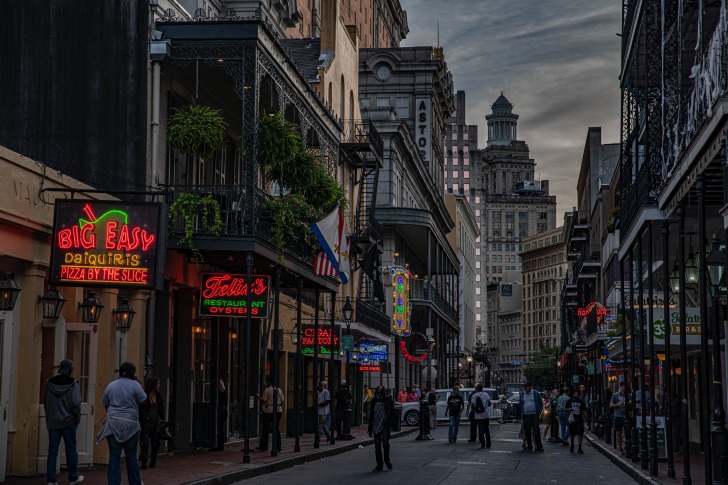

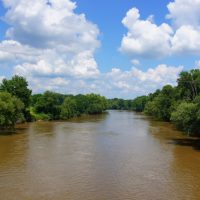

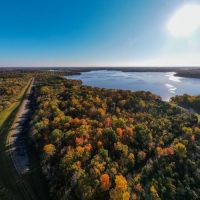






Alligators can be found in and around New Orleans due to its ideal climate and habitat, but sightings within the city are rare.